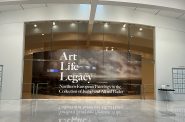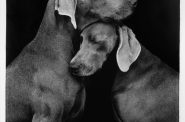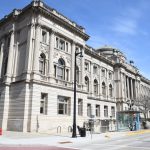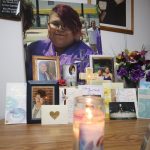The Barefoot Artist
International artist Lily Yeh comes to Milwaukee to talk about how art can transform a community.
In 1986, Lily Yeh was asked to create an art park in an abandoned lot in inner city North Philadelphia. It was the start of second career for Yeh, a native of China who had immigrated to the U.S. in 1963 and had been a professor of painting and art history at Philadelphia’s University of the Arts since 1968. Yeh went on lead projects that transformed more than 120 other lots into gardens and parks. She eventually created the organization, Barefoot Artists Inc., which has worked internationally, using art to transform impoverished communities.
Yeh has come to Milwaukee to discuss the impact art can have on a community. On Sunday, January 12, 5 p.m., “An Evening with Lily Yeh” will be presented at the Fox Bay Cinema Grill, and on Monday, January 13 from 8:30 a.m. to 4:30 p.m. at St. Matthew’s Lutheran Church in Wauwatosa, Yeh will offer a hands-on art workshop and presentation titled “Community Building Through Art.” She agreed to an interview with TCD.
Lily Yeh: When I was young I think I liked to draw. All children have natural talent to draw, but when I was 15 my father loved Chinese landscape painting and he got me a teacher and so from the age of 15 I was pursuing painting pretty seriously. I was studying Chinese landscape painting in the traditional style. You learn by copying master’s work so after every painting there’s a sense of accomplishment. That method of learning is also very restricting of personal creativity, but, I think because of this great tradition I came in contact with a special place the Chinese call the dustless world, it’s a more spiritual place, it’s very soothing, very beautiful, very calming. So that really set the course of my life because I fell in love with the tradition and what I discovered through this creative process.
TCD: How did moving to the U.S. change your outlooks on life and art?
LY: Everything. (laughs) When I came to the states, that was during the 60s, and American art was leading the modern art movement, so what it encourages is not so much tradition, but maybe anti-tradition and finding different ways to express our new world. And so at the beginning it was totally chaotic for me and I kind of lost my bearings. But then, out of that disorientation and lack of direction and chaos, you have to shake off the traditional way, imposed aesthetics and so forth, and re-find my footing in a new world and that’s when my personal voice began to emerge.
TCD: You spent many years teaching, did that change your art or your views on art?
LY: Oh, absolutely. One learns the most in teaching. For example, in Western art in the 60s, 70s and 80s, the kind of foundation training is still very important, the tone quality, shading, and volume, structure. Chinese tradition emphasizes the brush quality, the air moving through the movement of the brush, and so through teaching, I learned the most. I teach and learn at the same time. It was very, very powerful.
TCD: The name of your group, The Barefoot Artists, is that meant to echo the old barefoot doctors of China?

Recognizing that creativity and beauty are powerful agents for healing and change, Barefoot Artists works with poor communities around the globe practicing the arts to bring healing, self-empowerment and
social change.
LY: Yeah, I don’t know if you know this, but I didn’t start with Barefoot Artists. My initiation happened in inner city North Philadelphia in a poor African American community. So that’s where I did my first summer project in 1986. So then, I learned that art is so powerful in places broken. In places that don’t have resources. But then, in those places of darkness, you make creativity, you bring color in, you involve children, people who want to join you, and you create joy. That’s like lighting a fire in the darkness of the winter’s night. The power of art makes this place visible. And then with people joining you have other resources, and slowly the building of community, the transformation happens. And so, I went there for one summer project and it transformed me. It really changed the course of my life and then I co-created this organization called the Village of Art and Humanities. And after 18 years I decided to take the work internationally to places broken in the world and then I formed Barefoot Artists. Yes, the model is how the barefoot doctors would be so simple and take their little bags of things they need and just go to very remote villages and help people to heal. So I call it Barefoot Artists. You go to places where people cannot afford shoes.
TCD: Was the first art park that you built in Philadelphia the first time you realized how powerful and healing art could be?
LY: Yes. In 1986 I was invited in by Arthur Hall, a very well-known African American dancer/choreographer (who asked her to create an art park next to his studio), and it was inner-city, you know, a lot of abandonment. Broken land, broken people; children on the street and drugs and I was very scared. The first summer I wasn’t sure, but then the experience was so deep. It was so powerful and I realized that despite abandonment of the society from all levels, yes, art, action, creativity, color, can bring joy. It lights up hope. The first park was transformed into something so beautiful and then I realized beauty and art can heal and transform. And then I was hooked. I said wow, this is deeper, more profound and more powerful than anything I have done. It’s almost like a channel; energy that is hidden and buried and wounded, and you’re a kind of catalyst of a community, community voices, community energy.
TCD: How do you decide where Barefoot Artists projects take place? Do you research and select locations yourself or do people invite you?
LY: Usually people come to me. I always say that life beckons and my job is to be brave enough to respond. Usually, I do research after there is an invitation. But then there are exceptions when I was moved by a situation, like in Rwanda. In 2004 I was doing a project in Kenya, but I didn’t have Rwanda even on my agenda. But I heard someone talking from Red Cross from Rwanda of the suffering of the people and I was very moved and I thought, I need to go there. I went there, which was a little scary because I didn’t know anybody. And then I met a person whose speech moved me very much and we collaborated. The ten-year project unfolded that builds community, heals survivors, and then the most important work is the building of the genocide memorial. And so it all depends, but it’s organic, and it’s in the moment. I need to know the project can root in the community and has the potential to grow.
TCD: What do you think your life would be like if you had never been asked to create that first art park?
LY: I don’t know. I just know that now I’m living a life of freedom because I have less fear of broken places. And by going to the heart of darkness, I realized that there’s enormous potential and possibility and light there. And that is the very tale of beauty and beast. The darkness is trapped in destructive energy, and if we have the compassion and bravery to go towards it and not to run away, to hear, to understand, and to work with it, it has the power to transform darkness into light and the beast into beauty.
TCD: When creating an art park: does that require an urban setting to truly work?
LY: An urban setting art park is very powerful because we have so much abandoned space in urban areas…everywhere in American major cities. But it can be anywhere. Imagination can make the space anywhere, in any shape it needs to be.
TCD: What is your favorite part of the process with your Barefoot Artists projects?
LY: I think my favorite is when I finally see the artwork completed according to my standards. A lot of times I can’t reach that because when you do community work there are a lot of restrictions. Sometimes it’s the space. For example, in an urban space sometimes you cannot shape it the way you want to and sometimes people have different ideas, but when I began the Village of Arts and Humanities (in Philadelphia), because the urban space was so broken, that gives me almost total freedom to shape the space the way I see fit — poetic, mysterious, or beautiful, according to my artistic imagination, and that’s my favorite part. That’s my reward. That’s wonderful.
TCD: Do you consider yourself more an artist or an arts facilitator?
LY: Artist, always. Always. But artist with a very unique process that incorporates and empowers all participants, but it is my art.
TCD: Do you have any future projects lined up right now?
LY: Yes, I have a project in Palestine and projects in Taiwan working with indigenous tribes very similar to American Indian tribes. Their culture is under threat, under assault. They’re losing their young people and they’re losing their identity because of mainstream economic and social forces that are so powerful. I am working with them and using art trying to help preserve their local culture and their artistic tradition and language, so it’s fascinating. I’ve been involved in groups in Mexico so a project is potentially happening there.
TCD: What will you talk about in Milwaukee?
LY: I think Milwaukee is ready for transformation. It’s a wonderful city near the lake, it has its own history and neighborhoods but there are parts hoping for reconnection, restoration, recognition and creativity. We can all step into that and reach the power inside of ourselves and feel deeply fulfilled. That’s the experience I want to share.
On Sunday, January 12, the public is invited to “An Evening with Lily Yeh” from 5 p.m. to 8:30 p.m., which will feature live music, a screening of her documentary The Barefoot Artist, and a discussion with Yeh at the Fox Bay Cinema Grill. General admission tickets are $25. In addition, admission to Sunday’s event is included with $75 ticket to a hands on art workshop and presentation titled “Community Building Through Art” on Monday, January 13 from 8:30 a.m. to 4:30 p.m. at St. Matthew’s Lutheran Church in Wauwatosa. Tickets are available online.
Art
-
Exhibit Tells Story of Vietnam War Resistors in the Military
 Mar 29th, 2024 by Bill Christofferson
Mar 29th, 2024 by Bill Christofferson
-
See Art Museum’s New Exhibit, ‘Portrait of the Collector’
 Sep 28th, 2023 by Sophie Bolich
Sep 28th, 2023 by Sophie Bolich
-
100 Years Of Memorable Photography
 Sep 18th, 2023 by Rose Balistreri
Sep 18th, 2023 by Rose Balistreri


















I love the quote from Lily Yeh, “I teach and learn at the same time.”